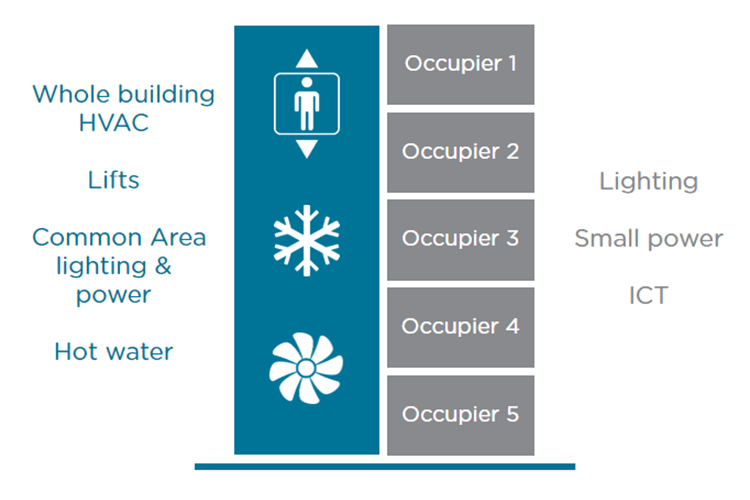Managing for Performance: Delivering Net Zero Carbon at Existing Buildings
11 December 2020Managing for Performance: Delivering Net Zero Carbon at Existing Buildings
11 December 2020The Better Buildings Partnership’s (BBP) Design for Performance (DfP) initiative took a huge step forward on the 26th November with the announcement of their partnership with NABERS to form NABERS UK, and with the BRE as scheme administrators.
NABERS UK has two market offerings: NABERS Design for Performance and NABERS Energy ratings. Whilst NABERS Design for Performance will be focussed on how new buildings are designed, built and commissioned in order to achieve net zero carbon in operation, there is an urgent need to ensure sufficient focus is given to how we assess and improve the existing building stock.
Existing buildings have an essential role to play in our broader pursuit of net zero carbon given that when the deadline ticks over in 2050 at least 70% of the buildings that will be standing exist today, and 50% of those were constructed prior to 1970. As Property Managers we must develop effective ways to assess:
- How these buildings have been designed;
- How they are performing in operation;
- How they can be optimised to ensure they are meeting the design intent; and,
- How they can be improved to maximise efficiency.
With this in mind it was a welcome announcement to hear that, as part of the NABERS UK launch, that a tool to assess existing buildings, commercial offices at least, through the use of the NABERS Energy ratings.
NABERS Energy measures the efficiency of an office building and rates its performance. The energy rating works by comparing the energy consumption of a building against a set of benchmarks that have been developed using actual data.The rating applies to the base building performance.This includes central services which are under the control of the Property Manager like heating and cooling systems, lifts and lobby lighting allowing office buildings to be compared based on how the central services are being run to provide a comfortable working environment for users.
For Property Managers this is a welcome development as existing benchmarks, not least the BBP’s own Real Estate Environmental Benchmark (REEB), tend to assess performance of the whole building, a proportion of which includes unregulated energy, which can account for up to 50% of the total energy, largely consumed within occupier demises. Isolating the base building enables Property Managers to report on the success of efficiency projects undertaken on central plant or in common areas, but more importantly than that it enables an assessment of the operational performance against the design intent of the property.
To that end NABERS Energy helps solve a conundrum that the Managing Agent’s Partnership has been wrestling with since BBP members, our clients, pledged to meet the requirements of the BBP’s Climate Change Commitment.
As mentioned above, existing buildings must have appropriate plans in place to make a significant contribution to the required reduction pathways. But can they, and if so, what is the extent of their possible contribution? It makes sense that certain DfP principles should be made applicable to existing buildings as a means of ensuring that an assessment of the design specification of any building could be made and compared to its operational performance. Should there be a performance gap between the two the Property Manager can look to assess how the gap might be closed, ideally through adjustments to management practice on site.
This then provides a starting point from which to assess how performance can be improved further, maybe even down the CRREM target for that asset type!
More importantly it enables Property Managers to report on the management (expressed in terms of energy intensity, or a NABERS star rating) of an assessment RELATIVE to its potential, if a building is designed to consume 300kWh/m2, and reports a similar figure for operational intensity while we might agree the performance is terrible, it may simply be limited by its specification.
This then opens the door for a full review of that specification and the identification of interventions that might be made to improve performance through management practice, plant replacement, reviews of building fabric and so on.Taking this approach enables plans to be produced for discussion with the property owners leading to the development of an implementation plan, or a view to be taken on the risk posed by the property in line with the net zero carbon strategy.
The project, nominally proposed as Managing for Performance, which will commence early in 2021 could not only be used by property owners or managers to assess real estate holdings but might also be used when considering which assets to purchase. Its inclusion in the due diligence process would enable fully informed decisions to be made around the stranding risk that might exist, or the value of the investment required to bring the asset up to standard.
The ability to assess existing buildings has since been brought into sharper focus with the Climate Change Committee’s report on the 6th Carbon Budget for the UK stating that plans should be accelerated for a new in-use building performance standard for commercial properties, with all renovations on commercial property to be completed by 2030. Managing for Performance could contribute to the development of such a standard, and enable such renovations to be identified and completed in line with the proposed timescale.

